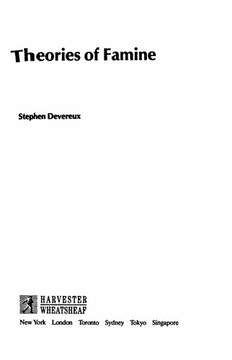
Theories of Famine: From Malthus to Sen PDF
Preview Theories of Famine: From Malthus to Sen
Theories of Famine Stephen Devereux g p HARVESTER m WHEATSHEAF New York London Toronto Sydney Tokyo Singapore First published 1993 by Harvester Wheatsheaf Campus 400, Maylands Avenue Hemel Hempstead Hertfordshire, HP2 7EZ A division of Simon & Schuster International Group © 1993 Stephen Devereux All rights reserved. No part of this publication may be reproduced, stored in a retrieval system, or transmitted, in any form, or by any means, electronic, mechanical, photocopying, recording or otherwise, without the prior permission, in writing, from the publisher. Typeset in 10/12 pt Times by Keyboard Services, Luton Printed and bound in Great Britain by T.J. Press (Padstow) Ltd British Library Cataloguing in Publication Data A catalogue record for this book is available from the British Library ISBN 0-7450-1417-8 (pbk) 12 3 4 5 97 % 95 94 93 To Gillian Contents List of figures xi Acknowledgements xiii Part 1 The nature of famine 1 1 Introduction 5 2 What is famine? 9 2.1 Dictionary definitions 10 2.2 Food shortage definitions 10 2.3 Famine as mass starvation 11 2.4 'Behavioural' definitions 14 2.5 insider' definitions 16 2.6 Conclusion 18 3 The evolution of famine theory 21 3.1 Act of God or act of man? 21 3.2 Supply failure or demand failure? 23 3.3 Famine theory: multiplicity and simplicity 28 3.4 Towards a taxonomy of famine theories 30 Part 2 Theories of famine 33 4 Climate and famine 35 4.1 Climate and 'natural famine regions' 35 4.2 Drought and famine 38 4.3 Seasonality, vulnerability and famine 42 4.4 Conclusion 44 vii viii Contents 5 The population monster 46 5.1 Malthusian theory 46 5.2 Critique and contra-Malthusian models 49 5.3 Neo-Malthusianism 51 5.4 Modern demographic arguments 53 5.5 Policy implications 57 5.6 Conclusion 62 Appendix 5.1 A graphical representation of Malthus's model 63 6 The entitlement approach 66 6.1 The basic entitlement approach 66 6.2 Strengths of the entitlement approach 69 6.3 Entitlements versus income 74 6.4 Limitations of the entitlement approach 76 6.5 Conclusion 81 Appendix 6.1 Entitlements and starvation : a graphical approach 82 7 Famine and food markets 86 7.1 Basic propositions 86 7.2 Market dependence and demand failure 88 7.3 Expectations, speculation and hoarding 91 7.4 I mperfect or fragmented markets 94 7.5 Conclusion 99 Part 3 The political economy of famine 101 8 The management of natural resources 103 8.1 'Natural degradation' 104 8.2 'Indigenous ignorance' 105 8.3 'Malignant exploitation' 110 8.4 Conclusion 112 9 Famine and development 114 9.1 Marginalization and development 115 9.2 Commoditization and market dependence 117 9.3 The moral economy meets colonial capitalism 120 9.4 Vulnerability as a 'phase of developmenf 121 9.5 Case study: the Sahelian famine, 1969-74 124 9.6 Conclusion 126 10 Famine and government policy 129 10.1 Urban bias 130 10.2 Agricultural regulation 133 Contents ix 10.3 Response failure 137 10.4 Case study: the Soviet famine of1932-4 140 10.5 Case study: the Chinese famine of1958-61 142 10.6 Conclusion 146 11 War and famine 148 11.1 Militarization 148 11.2 War 150 11.3 Refugees 155 11.4 Case study: the Netherlands, 1944 159 11.5 Conclusion 161 12 Famine and international relations 164 12.1 International food markets 165 12.2 International responsibility and response 167 12.3 The politics of food aid 171 12.4 Case study: the 1974 Bangladesh famine 174 12.5 Conclusion 176 Part 4 Conclusion 179 13 A summary of theories 181 13.1 Defining famine 181 13.2 Theories: background 182 13.3 FAD theories 182 13.3.1 Climate 182 13.3.2 Population 183 13.4 Economic theories 184 13.4.1 Entitlements 184 13.4.2 Market failure 185 13.5 Political economy explanations 186 13.5.1 Natural resources 187 13.5.2 Development 187 13.5.3 Government policy 188 13.5.4 War 189 13.5.5 International relations 189 13.6 Policy implications 190 13.7 Conclusion: determinants of vulnerability 191 Bibliography 193 Subject index 203 Name index 206 Figures Figure 5.1 A graphical representation of Malthus's model $ Figure 6.1 Illustration of endowment and entitlement 8 Figure 7.1 Demand failure and market failure 3 Figure 7.2 Market dependence and famine 3 Figure 8.1 Ecological degradation and famine 113
